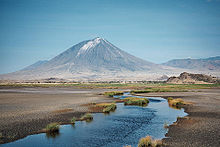Ngorongoro Conservation Area[dead link] is a park and UNESCO World Heritage site in Northeast Tanzania. It contains an old volcano that has collapsed and formed a crater (caldera). The steep sides of the crater have become a natural enclosure for a wide variety of wildlife.
Understand
[edit]
History
[edit]Considered to be "the cradle of humanity".
Landscape
[edit]The Ngorongoro Crater is geologically speaking not a crater, but a collapsed volcano. It is a natural "utopia" for East African wildlife, and thus is rich in a wide diversity of animals. Roughly 100 square miles (260 km²) of savanna is completely encircled by a mountainous ring which is covered in dense jungle. Ngorongoro Crater is the largest unbroken caldera in the world, with a diameter of roughly 21 kilometers. The walls of the crater rise on average 600 meters above the floor. The rim of the crater is approximately 2 200 meters above sea level.
The Ngorongoro Crater is located in a highland area, called the Ngorongoro Crater Highlands, and is the largest of three major craters/calderas in this area; the other two are Empakai Crater and Olmoti Crater.
Flora and fauna
[edit]Lions are in the highest density in the world in the crater, so there is a good chance of seeing them. There are herds of wildebeest, zebra, and a lot of buffalo and Grants' gazelles too. This is one of the best places in East Africa to see a Black Rhino. Hippos and flamingos are seen in Lake Magadi. Hyenas are a common predator, and cheetahs are frequently seen. Leopards are in the conservation area but rarely seen, along with Wild Dogs. The crater is a special protection area for rhinos.
Climate
[edit]Ngorongoro Crater is, due to its altitude, a lot cooler than most areas in northern Tanzania. The rim of the crater experience chilly nights and mornings, especially between May and August and temperatures are moderated through out the year. The floor of the crater can on days with little wind become quite hot in the afternoons, especially in the hot months between October and March. The Ngorongoro Crater has distinct dry and rainy season with the rainy season being from mid-November to mid-May, but a slightly drier period in January and February and the dry season between mid-May and mid-November. The dry season is not entirely dry however, rain does occur. Due to rain patterns in East Africa, where rain mostly comes from the east, there is actually quite a significant difference between the eastern and the western, outer, slopes of the crater, with the western side being noticeably drier. The eastern side is dominated by forests and quite dense vegetation where as the slopes on the western side of the crater is open and quite dry savannah.
Get in
[edit]Most people come to Ngorongoro from Arusha on organized safaris. It is, however, cheaper to organize a safari from Karatu, a town 10 km from the gates. Here you can organize a safari with an independent driver. If using an independent driver, the profit will go to an individual Tanzanian instead of a larger safari company, however these vehicles are less reliable and are known to have parts fall off while driving around the crater. That can add or detract from your experience, depending on what you're looking for.
Fees and permits
[edit]For foreigners:
- US$70.80 per person/day.
- US$295 per car/day (not a car full of people, just the car.)
No credit cards or cash are accepted, payment by prepaid TANAPA card only.
For Tanzanians it's Tsh 15,000 per day. Most of the locals believe that the bulk of the park fees go into pockets.
Get around
[edit]See
[edit]
Over a million years old
- 1 Olduvai Gorge. One of the most important sites for the investigation of human evolution and adaptive technology. There is a small museum with a collection that includes two million year old fossils and stone tools found in the gorge.
- 2 Empakaai Crater. This extraordinary caldera (collapsed volcano) consists of a ring of cliffs encircling, some 300 m below, a salt lake around 6 km across. Its colours range from vivid turquoise to sparkling marine to pewter, depending on the time of day and the mood of the cloudscape.
- 3 Olmoti Crater. Beautiful landscape for a hiking safari. Olmoti Craters’s floor is shallow and covered with tussocks of grass. Besides the Maasai and their livestock you can sometimes see eland, buffalo and reedbuck.
- 4 Ol Doinyo Lengai. is an active volcano located northeast outside the park. It's a long and difficult drive to reach it.

Do
[edit]- 1 Hiking (close to Lake Natron Camp Site). Scenic hike in a canyon of a stream leading in to Lake Natron. Go and return to a small waterfall which you can dive through into a hidden cave. Guide is required.
Buy
[edit]Eat
[edit]Drink
[edit]Sleep
[edit]Lodging
[edit]Camping
[edit]Backcountry
[edit]Stay safe
[edit]Go next
[edit]


